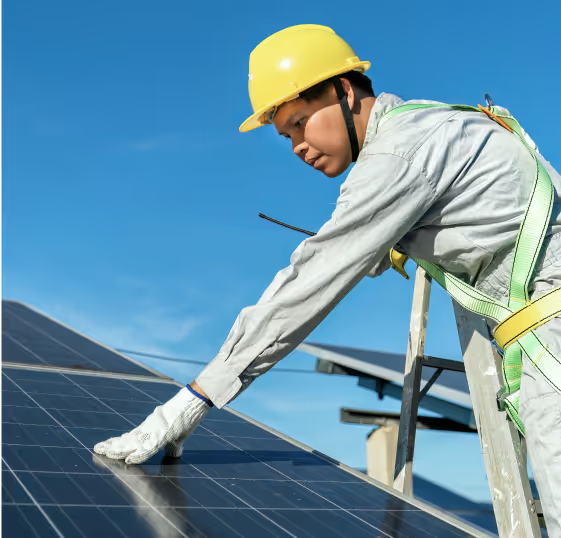GetSolar – The Trusted Solar Panel Company in Singapore
Unlock your savings while saving the planet. We make the process of getting solar simple for you through our zero-upfront cost plans.














Protect Your Roof
Excessive heat from the sun can cause warping of your roof. Installing solar panels for your home can thus act as an added shield, preventing direct sunlight and minimising heat influx into your living space.
Reduce Carbon Footprint
Solar energy is one of the cleanest forms of energy available as it generates electricity without producing carbon dioxide. With sunny weather all year round, it is also a reliable source of renewable energy for your home.
Enjoy Cost-Savings
Installing solar panels can help optimise underutilised roof space. Depending on your electricity consumption and roof size, you can enjoy greater cost savings, potentially cutting your electricity bills by up to 80%!
Why Use Solar Energy?
As one of the leading solar panel companies in Singapore, we are at the forefront of encouraging homeowners to adopt solar panels for their homes. Solar energy, being an accessible source of power in Singapore, aligns perfectly with the vision of a zero-carbon future.
This makes solar energy an optimal solution for transitioning to sustainable energy.




Our solar panel systems can help you save up to 70% on your electricity bills. Our Renewable Energy Certificate (REC) programme also allows you to earn extra income by selling the clean energy your panels generate!
Switching To Solar Made Easier With GetSolar
As a leading solar panel company in Singapore, we make switching to solar easy for you with our efficient and hassle-free process. We understand that the world of solar technology can be complex, which is why we ensure that most of the work is handled by us. All you need to do is request a quote and our team of experts will guide you through the next steps!
Types of Solar Plans at GetSolar
We are a leading and trusted solar panel company in Singapore, with an unwavering commitment to offering value plans to meet the needs of both homeowners and businesses.
Solar for Homes
Go solar for your home with Singapore’s first Rent-To-Own solar programme or opt for an upfront purchase plan.

Solar for Businesses
Embrace sustainability for your business through a Power Purchase Agreement (PPA) or an upfront purchase plan.

Who We Are
Our team of specialists possesses in-depth knowledge of solar panels and solar panel technology. We ensure you have the information needed to make well-informed decisions.

Frequently Asked Questions
Is it worth installing solar panels for my home?

In short, yes! Solar panels are a win-win: you save on electricity bills and get paid for the clean energy you contribute back to the grid. Additionally, you’re helping the planet.
In Singapore’s climate where it is sunny all year round, installing solar panels for your home can help you save energy and costs. However, how much you save is dependent on your roof size and site conditions. Find out how much you can potentially save with our solar calculator tool.
Are solar panels a good investment?

Absolutely! Given Singapore’s rising electricity prices, solar panels are a smart move to cut down on those expensive bills while helping save the planet.
The amount of savings you can enjoy will largely depend on 3 factors:
- Your energy consumption patterns
- Your existing electricity retailer and utility rate
- The number of solar panels that your roof can accommodate
Plus, thanks to Singapore’s energy export structure, you can also earn from selling extra power back to the grid. You’re looking at a payback period of 5-8 years for a system that will last you over 25 years. A pretty solid investment, if you ask us.
You can estimate your potential savings with our solar calculator today!
Can I sell excess solar energy back to the grid?

Absolutely! You can be compensated for any unused solar energy your system generates that is put back into the grid.
If you get your power through SP Group, you will receive payments at the regulated tariff minus grid charges. This is about 75-80% of the cost you pay for electricity (or about S$0.22/kWh as of early 2025). You will receive this as a rebate through SP Group that offsets your future bills.
If instead you get your power through an Open Electricity Market (OEM) retailer, your solar export payments will be based on the Wholesale Uniform Singapore Energy Price (USEP). Note that this price can fluctuate greatly between S$0.10/kWh to S$0.50/kWh. You will receive this as a remittance cheque through SP Group, or you can also request for it to be credited to your bank account by submitting a GIRO form to SP Group.
Ready to Go Solar?
If you have any inquiries or need support, our team of cheerful solar elves is here to assist you! Reach out to us on WhatsApp or drop us a message at support@getsolar.ai, and we’ll be at your service!


















